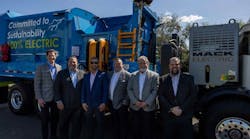Coastal Waste & Recycling receives Mack LR Electric Refuse vehicle during e-mobility event
Coastal Waste & Recycling recently received its first battery-electric refuse truck, the Mack LR Electric model. Mack executives handed over the EV during an e-mobility event with the company, Volvo Construction Equipment, Nextran Truck Centers, and local officials.
“Mack is proud to be partnering with Coastal Waste & Recycling in their journey toward electrification,” Jonathan Randall, president of Mack Trucks North America, said. “Coastal’s commitment to sustainability is evident through their efforts to bring battery-electric vehicles to serve their customers in southern Florida, and we appreciate their enthusiasm for reducing GHG emissions and environmental care.”
Brendon Pantano, CEO of Coastal, said he ordered the Mack LR Electric refuse vehicle because of the company’s long-standing relationship with Mack and Mack’s reputation in the refuse industry.
“We are excited to add both pieces of equipment to our fleet,” Pantano said. “As the first private hauler in Florida to invest in electric, such as the Mack LR Electric refuse vehicle, we look forward to harnessing the strength of this strategic move to further elevate innovation in our operations.”
See also: Truck market to remain ‘robust,’ Mack boss says
The Mack LR Electric will operate in residential and certain specialized commercial applications. Mack and Coastal Waste & Recycling worked together to develop favorable routing for the LR Electric to ensure that the refuse truck will complete a full day’s work based on the application needs. Coastal’s LR Electric is equipped with an automated side loader.
The next generation Mack LR Electric offers a standard 376 kWh total battery capacity for 42% more energy and increased range between vehicle charges. Twin electric motors produce 448 continuous horsepower and 4,051 lb.-ft. of peak torque output from zero rpm.
Four NMC lithium-ion batteries, charged through a 150 kW, SAE J1772-compliant charging system, power the vehicle and all onboard accessories through 12V, 24V, and 600V circuits. The two-stage regenerative braking system helps recapture energy from the hundreds of stops the vehicle makes daily with an increasing load.



